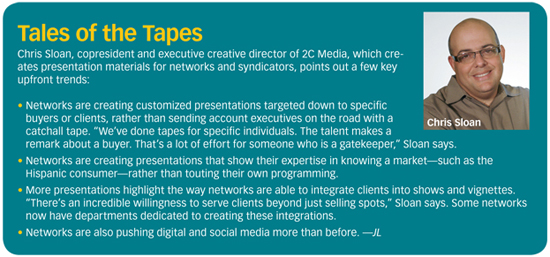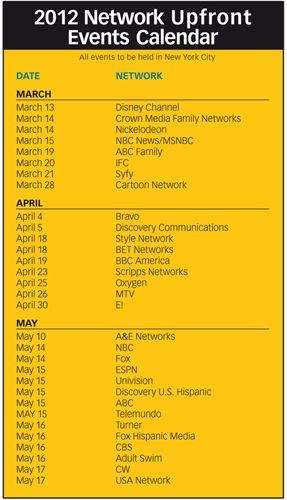Challenge for Networks Is to Create More Memorable Upfront Presentations for Marketers

It's only
January, but it's already upfront time for the people who put together the
presentations designed to lure the $18 billion in advertising dollars that
media buyers will parcel out starting in late May for the 2012-13 season.
Network execs are
assembling reams of research, culling clips from shows and looking for ways to
make their massive strategy plays interesting and original-even
unforgettable-to buyers who have seen it all many times before. Some
presentations networks assemble will be aimed at a single buyer or client.
Others will be shown in giant venues like Radio City Music Hall. And as CBS
chief Leslie Moonves likes to remind us every year at his May presentation in
the historic venue: How do you get to Carnegie Hall? Practice, practice,
practice.
"Media buyers
have seen hundreds of these presentations. You have to make your stuff stand
out and be very entertaining and memorable," says Andy Baker, VP and creative
director at National Geographic Channel. "Make them smile. Make them get a
goose bump. Really wow them. I've worked on upfront every single year for the
last 10 or 11 years, so I've learned a little lesson in each along the way."
"In terms of the
day-to-day, it's probably front-of mind about six to eight months of the year,"
says Patrick Trettenero, creative director at USA Network. "And the rest of the
year, we're either analyzing what we just did, or starting to think about what
we're going to do the next year."
Buyers are also
getting into upfront mode. "We're getting to around that time in late January
where people are starting to think a little bit about ‘Hey, it's going to be
upfront pretty soon,'" says Gary Carr, senior VP, executive director of
national broadcast at Targetcast. "Within the next month or two we're going to
have to make presentations to our clients talking about where we see the
market. That's what's going on right now."
New tactics are
already at work. This year, networks are waiting until March before holding
events. During the past two years, MTV was among the early birds, putting on a
show last February at the Hammerstein Ballroom featuring music by Bruno Mars.
The network was struggling and wanted an uncluttered time to explain its new
strategy to buyers. Now, with ratings up, MTV will step up to the plate in late
April to be more in the thick of things.
Some networks,
like NatGeo, will hold meetings with individual agencies and clients and forgo
a major event. Others like FX will focus on fun, inviting buyers for a night of
bowling with the network's talent. Many nets will rent out a restaurant, a
loft, a theater or arena and put on a show and try to deliver their sales
message while entertaining clients.
Broadcasting & Cable Newsletter
The smarter way to stay on top of broadcasting and cable industry. Sign up below
As ratings and ad
revenue for cable networks have grown, their presentations have become more
elaborate. Top-rated cabler USA Network will hold an event during what has
traditionally been the broadcasters' week (this year starting May 14), joining
Turner Broadcasting and ESPN.
"More and more
cable networks are doing lavish presentations at nice venues with
entertainment," Carr says. "Those networks get a lot of money. They're getting
billions in sales and they're putting on better and better shows and they're
taking some of that primetime money."
Broadcasters Are
Baaaack
As for the
broadcast networks, they cut back during the recession but are now also
partying like its 1999. NBC, which stopped doing big presentations in 2008 and
2009, put on a full-scale schedule presentation last year on Monday morning of
upfront week, followed by a luncheon with its stars in attendance. NBC would
not discuss its 2012 plans. Fox takes its swings after NBC on Monday afternoon.
Fox also throws a big party in Central Park Monday evening.
ABC will once
again gather buyers at Lincoln Center to present its new schedule and sales
pitch Tuesday afternoon of upfront week. The network has been sending many
attendees home hungry and thirsty from that session, hosting an afterparty for
only big buyers and clients.
Those big
schedule announcements still deliver more than the shrimp usually served
afterward (though some have judged a network's upfront by the size of the
shellfish).
"For someone who
does what I do, it's important to be presented with the schedule and know what
the programming is going to look like," says Chris Geraci, president of
national broadcast at OMD. "I still think that it's a pretty efficient use of
one or two hours."
But for both the
broadcast and cable networks, a lot of the detail work gets done in smaller
meetings and presentations long before negotiations over CPMs start in May and
June.
"On a
client-by-client basis, I would think that the meetings that happen well in
advance of that week in May are the more important ones because [the networks]
hopefully have done their homework about why something might be good for a
particular advertiser," Geraci says.
Chris Sloan,
copresident and executive creative director of 2C Media, which creates
presentation materials for broadcast networks, cable networks and syndicators,
says networks have become much more strategic. "In the old days they would
spend $300,000 on these gigantic song-and-dance pieces," Sloan says. "It's a
different age. There's just so much more accountability now, and the economy's
obviously played a part of it."
Still it is
showbiz, so a lot of attention is put into getting the mix of information and
entertainment just right.
"Our first couple
of years, as we were introducing the brand and the channel, we had to work
really hard on the sales points and giving data of why they should advertise,"
says NatGeo's Baker. "And now our sales team says let's tell great stories and
show our great visuals because we believe that when people see the great shows,
they're just going to want to buy us."
Last year, USA
put on a big, broadcaststyle upfront at Lincoln Center. "In an effort to make
it very specific to USA and to our brand-Characters Welcome-we made the choice
to not have a single executive on the stage during the presentation," says
Trettenero. The statistics were also kept to a minimum. "We're the No. 1 cable
network for six years in a row now. Quite frankly, how many times do we need to
repeat that?"
But all the rest
of the details were revised almost obsessively.
"We fuss over the
design of the cocktail napkins at our upfront event," Trettenero says. "What I
can tell you, and I'm sure this is true for every network, is that there are a
lot of cooks in that kitchen. And that includes the network executives, the
sales executives, the [account executives] who are in the trenches having to
actually develop those relationships and make those deals, all of the creatives
who are working night and day. And we're all in it together."

Don't Mess With
Success
So, what tends to
make an upfront presentation successful?
Media buyers and
planners tend to be a young group, so it's important that a presentation be
current in terms of language, pop-culture reference, editing techniques,
special effects and music.
"You can't do anything
that's old fashioned and corny and feels like your father's upfront," says
Trettenero. "These days, the buyers are hipper and younger than the network's
audience."
Music is
important in presentations. "We've always worked really hard to make sure the
music we're creating is unique and different and also connects back to the
brand," says NatGeo's Baker. "You're always mining different sites to find
pieces of music that other folks aren't using." That can be tricky. Last year
it seemed almost every network played Katy Perry's "Firework," making it a bit
of a cliché.
Speaking of clichés, it's also good to avoid overused buzzwords. 'Transmedia'
was used so much last year that by June, no one really knew want the word
meant, Trettenero says.
The alternative approach is humor, especially when it's self-deprecating. "The
more times you can bite the hand that feeds you, that still creates relevance
to a buyer because you're able to laugh at yourself, like when Jimmy Kimmel
comes up and eviscerates the network" at ABC's upfront, Trettenero adds.
NatGeo's Baker notes that printed presentation materials are becoming digital.
Upfront Websites are increasingly common, with games, prizes and other
incentives to keep buyers coming back.
And, buyers and network executives say, another important attribute of a
successful upfront presentation is brevity.
Jon has been business editor of Broadcasting+Cable since 2010. He focuses on revenue-generating activities, including advertising and distribution, as well as executive intrigue and merger and acquisition activity. Just about any story is fair game, if a dollar sign can make its way into the article. Before B+C, Jon covered the industry for TVWeek, Cable World, Electronic Media, Advertising Age and The New York Post. A native New Yorker, Jon is hiding in plain sight in the suburbs of Chicago.










